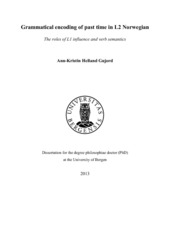Grammatical encoding of past time in L2 Norwegian: The roles of L1 influence and verb semantics
Doctoral thesis
Permanent lenke
https://hdl.handle.net/1956/6867Utgivelsesdato
2013-06-07Metadata
Vis full innførselSamlinger
Sammendrag
The focus of the present thesis is the encoding of past time in L2 Norwegian. In Norwegian, the notion of past is grammaticalised through two categories, the preterite and the perfect, which are the two main structures that will be addressed in the study. The overall aim is to explore the grammatical encoding of past time in texts written by Vietnamese (N=99) and Somali (N=97) learners of Norwegian. The texts are assessed to be at proficiency level A2 or B1 of the Common European Framework of Reference (CEFR), and are extracted from a learner corpus of Norwegian (ASK). The investigation is guided by two different theoretical positions in research on second language acquisition (SLA): 1) a language-specific perspective on second language acquisition that assumes that the learner’s L1 can affect the acquisition of temporal morphology, and 2) a universalistic perspective on second language acquisition that assumes that the learner primarily displays universal tendencies and patterns in the acquisition of tense and aspect forms in the L2 (as described in the Aspect Hypothesis) (Bardovi-Harlig 2000; Shirai 2009). These two perspectives are often positioned as competitors; however, in the current study, both of them are included in order to gain a broader view of the acquisition of L2 morphology, and in order to benefit from findings that come from the different strands, but which are nonetheless connected. For instance, although there is a substantial amount of research to support the Aspect Hypothesis, which represents the universalistic position in the present thesis, and which considers the influence of lexical aspect to be an acquisitional universal, later studies within this line of research suggest that the L1 has an effect on the acquisition of temporal morphology (Ayoun and Salaberry 2008; Collins 2002, 2004; Izquierdo and Collins 2008; Rocca 2002, 2007). In addition, these studies also indicate that there is an interaction between lexical aspect and L1 influence (Collins 2002, 2004; Izquierdo and Collins 2008). These findings align with studies that seek to reveal how the conceptualisation and grammatical encoding of time in the L1 affect L2 acquisition (Alloway and Corley 2004; Boroditsky and Trusova 2003; Carroll and Von Stutterheim 2003; Polunenko 2004; Von Stutterheim, Carrol, and Klein 2009; Von Stutterheim and Nüse 2003). These studies have found that L2 learners have difficulties encoding temporal information in the same way that native speakers do, and that this encoding is particularly challenging when the L1 and L2 conceptualise and grammaticalise time differently. An important part of the thesis is the contrastive analysis of the target language, Norwegian, and the learners’ L1s, Vietnamese and Somali. In order to base the analysis of L1 influence on reliable and nuanced information about the contrastive relations, a method of eliciting information about temporal categories in languages, the translation questionnaire method, is adopted from Dahl (1985, 2000). The similarities and differences revealed in the contrastive analyses of Norwegian and Vietnamese and Norwegian and Somali are also analysed in relation to Ringbom (2007). Based on the contrastive analyses, the two theoretical perspectives, and previous findings, research questions and associated hypotheses are raised. As to methods of analysis, the current study applies Jarvis’s (2000) methodological framework for the study of L1 influence. Furthermore, methodological issues are also of great importance in the exploration of the predictions in the Aspect Hypothesis, due to the complexity involved in the classification of verb phrases into distinct categories of lexical aspect. The research questions and hypotheses are analysed based on a stepwise statistical approach which is intended to reveal systematic differences between the groups compared. The main findings from the analysis can be summarised as follows: transfer effects are detected in the analysis; lexical-aspectual influence as predicted in the Aspect Hypothesis, which claims the acquisition of past morphology to be influenced by the telicity in verb phrases, is not revealed; and some kind of interaction of influence between the learners’ L1s and the temporal content in flectional categories is detected; however, the precise type of interaction is difficult to discern. Finally, the various findings are discussed against the backdrop of the theoretical perspectives and previous findings presented in the thesis.
